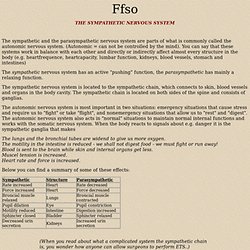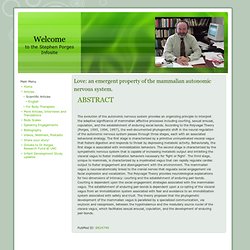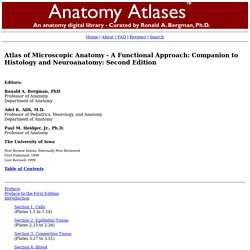

Stephen Porges, Ph.D.: Information and Links. Stephen Porges, Ph.D.

Stephen Porges: POLYVAGAL THEORY [gives theoretical background for ANS work of Klinghardt] The work of Dr. Stephen Porges, this helps explain some puzzling aspects of human Autonomic Nervous System behavior. Dr. Porges founded the Institute for Child Study where he has developed interventions that help children develop more control of their autonomic function and this improves the social dynamics of their relationships. Careful anatomical study has revealed nerve fibers from higher centers of the brain are contained in what is considered a main autonomic nerve bundle, the Vagus Nerve. In addition, the "Triune Autonomic Nervous System" gives added value to our recommendations that patient consider Family Constellation Work or Family Dynamics Work as part of their integrative medicine program. 1.
[On website of Nexus Journal] | Original interview: [PDF version] Stephenporges.com. Social Engagement System. The ventral vagal system is involved with most aspects of social contact and pleasure. It guides eye contact, hearing, eating, speech, singing, nursing, kissing, smiling, and some would say, direct heart to heart contact. Because of its role in making contact between different people favorable, the ventral-vagal system is a way of achieving personal safety, but it requires a moderate amount of actual safety to develop or stay employed. The Polyvagal Theory. Psychophysiology, 32 (1995), 301-318.

Sympathetic+nervous+system.jpg (JPEG Image, 600x642 pixels) Sympathetic nervous system. The sympathetic and the parasympathetic nervous system are parts of what is commonly called the autonomic nervous system.

(Autonomic = can not be controlled by the mind). You can say that these systems work in balance with each other and directly or indirectly affect almost every structure in the body (e.g. heartfrequence, heartcapacity, lumbar function, kidneys, blood vessels, stomach and intestines) The sympathetic nervous system has an active "pushing" function, the parasympathetic has mainly a relaxing function. The sympathetic nervous system is located to the sympathetic chain, which connects to skin, blood vessels and organs in the body cavity. The sympathetic chain is located on both sides of the spine and consists of ganglias. The autonomic nervous system is most important in two situations: emergency situations that cause stress and require us to "fight" or take "flight", and nonemergency situations that allow us to "rest" and "digest".
Polyvagal Theory. CN X.

Vagus Nerve. Psychoneuroendocrinology : LOVE: AN EMERGENT PROPERTY OF THE MAMMALIAN AUTONOMIC NERVOUS SYSTEM. Love: an emergent property of the mammalian autonomic nervous system. The evolution of the autonomic nervous system provides an organizing principle to interpret the adaptive significance of mammalian affective processes including courting, sexual arousal, copulation, and the establishment of enduring social bonds.

According to the Polyvagal Theory (Porges, 1995, 1996, 1997), the well-documented phylogenetic shift in the neural regulation of the autonomic nervous system passes through three stages, each with an associated behavioral strategy. The first stage is characterized by a primitive unmyelinated visceral vagus that fosters digestion and responds to threat by depressing metabolic activity. Discovery Service: Result List: polyvagal. Histology Atlas - Atlas of Microscopic Anatomy A Functional Approach - Anatomy Atlases. PrefacePreface to the First EditionIntroduction Section 1.

Cells (Plates 1.1 to 1.14) Section 2. Epithelial Tissue (Plates 2.15 to 2.26) Section 3. Connective Tissue (Plates 3.27 to 3.51) Section 4. Blood (Plates 4.57 to 4.62) Section 5. Appendices Appendix I: How to Study a Microscope Slide Appendix II: The Preparation of Cells and Tissue for Microscopic Study Appendix III: Methods of Fixation and Study Appendix IV: Comments on Color Groups, Stains, and the Staining Mechanism Appendix V: Nervous System Glossary of Terms References This Site's Awards, Reviews and Comments Home | About Us | FAQ | Reviews | Contact Us | Search Anatomy Atlases is curated by Michael P.
Please send us comments by filling out our Comment Form. All contents copyright © 1995-2018 the Author(s) and Michael P. "Anatomy Atlases", the Anatomy Atlases logo, and "A digital library of anatomy information" are all Trademarks of Michael P. Anatomy Atlases is funded in whole by Michael P. Viva Las Vagus Nerve. A corny title – but a cool nerve.

The 10th of the cranial nerves, it is often called the “Nerve of compassion” because when it’s active, it helps create the “warm-fuzzies” that we feel in our chest when we get a hug or are moved by a chick-flick. The vagus nerve is really a bundle of nerves that originates at the top of the spinal cord and enervates all sorts of organs. Here’s a picture: (Peter Jurek, www.peterjurek.com) That first little offshoot stimulates certain muscles in the vocal chamber, facilitating communication. You can see from this diagram that the vagus nerve branches off to everything from the neck down to the colon. Pretty easy to see how even the simplest yoga routine would stimulate lots of branches of this nerve.
But here’s something even cooler – the research that Dacher Ketlner, director of the Social Interaction Laboratory at the University of California, Berkeley is doing shows that stimulating that vagus nerve is not only good for you – it’s good for the planet!